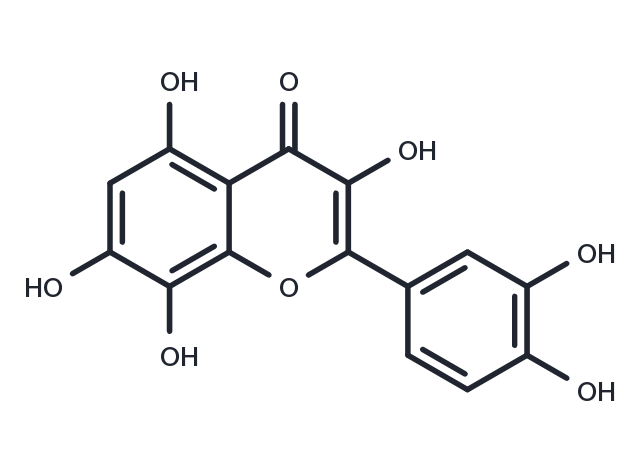store at low temperature
Powder: -20°C for 3 years | In solvent: -80°C for 1 year

Gossypetin, a hexahydroxylated flavonoid extractable from Rhodiola rosea Linn. is a potent MKK3 and MKK6 inhibitor that strongly attenuates the MKK3/6-p38 signaling pathway.Gossypetin exhibits antimutagenic, antiatherosclerotic, antioxidant, as well as cytoprotective and antimicrobial effects.It inhibits bone resorption by downregulating lysosomal caspase K activity and inducing autophagy-associated proteins in actin ring osteoclasts. Gossypetin has anti-mutagenic, anti-atherosclerotic, anti-oxidant, cytoprotective and antibacterial effects, and it inhibits bone resorption by down-regulating lysosomal caspase K activity and by inducing autophagy-associated protein in actin ring osteoblasts.

| Pack Size | Availability | Price/USD | Quantity |
|---|---|---|---|
| 1 mg | In stock | $ 222.00 | |
| 5 mg | In stock | $ 553.00 | |
| 10 mg | In stock | $ 789.00 | |
| 25 mg | In stock | $ 1,180.00 | |
| 50 mg | In stock | $ 1,590.00 |

| Description | Gossypetin, a hexahydroxylated flavonoid extractable from Rhodiola rosea Linn. is a potent MKK3 and MKK6 inhibitor that strongly attenuates the MKK3/6-p38 signaling pathway.Gossypetin exhibits antimutagenic, antiatherosclerotic, antioxidant, as well as cytoprotective and antimicrobial effects.It inhibits bone resorption by downregulating lysosomal caspase K activity and inducing autophagy-associated proteins in actin ring osteoclasts. Gossypetin has anti-mutagenic, anti-atherosclerotic, anti-oxidant, cytoprotective and antibacterial effects, and it inhibits bone resorption by down-regulating lysosomal caspase K activity and by inducing autophagy-associated protein in actin ring osteoblasts. |
| In vitro |
Gossypetin (60 μM; 3 h; KYSE30 and KYSE410 cells) strongly inhibits p38 activity in a dose-dependent manner and demonstrates that Gossypetin directly inhibits MKK3 or MKK6 activity. [1] Gossypetin (20-60 μM; 48 h; KYSE30, KYSE450, and KYSE510 cells) strongly inhibits anchorage-dependent esophageal cancer cell growth in a dose-dependent manner. [1] Gossypetin (20-40 μM; 48 h; KYSE450 and KYSE510 cells) reduces the S phase and induces cell cycle arrest in the G2 phase in a dose-dependent manner. [1] Gossypetin (20-40 μM; 72 h; esophageal carcinoma cells) induces intrinsic apoptosis in esophageal carcinoma cells. [1] |
| In vivo | Gossypetin (100 mg/kg; p.o.; 5 times a week; for 21 days; (SCID) female mice) leads to a notable reduction in the growth volume of esophageal tumors, while not causing a significant decline in body weight. Moreover, Gossypetin induces a notable decrease in Ki67 expression. Observable morphological distinctions between mouse tissues in treated and untreated groups were absent. Furthermore, Gossypetin treatment strongly suppresses the phosphorylation of p38, an immediate downstream protein of MKK3/6.[1] |
| Molecular Weight | 318.24 |
| Formula | C15H10O8 |
| CAS No. | 489-35-0 |
store at low temperature
Powder: -20°C for 3 years | In solvent: -80°C for 1 year
You can also refer to dose conversion for different animals. More
bottom
Please see Inhibitor Handling Instructions for more frequently ask questions. Topics include: how to prepare stock solutions, how to store products, and cautions on cell-based assays & animal experiments, etc.
Gossypetin 489-35-0 MAPK Microbiology/Virology oxidation-reduction p38 MAPK Antioxidant Antibacterial inhibitor inhibit
